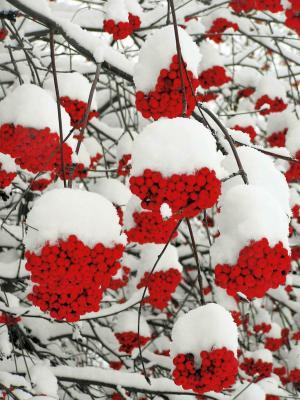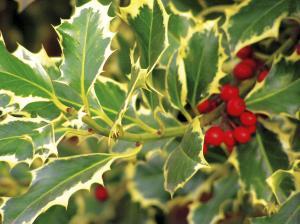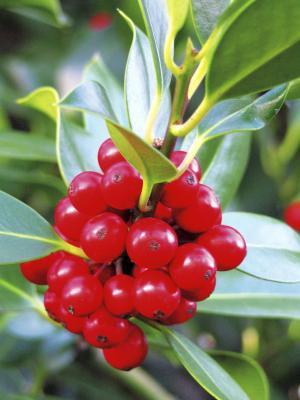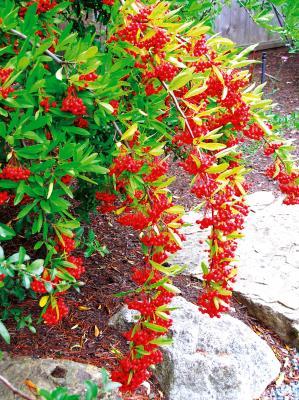Bringing back the jewels of the garden
By Jean Sorensen
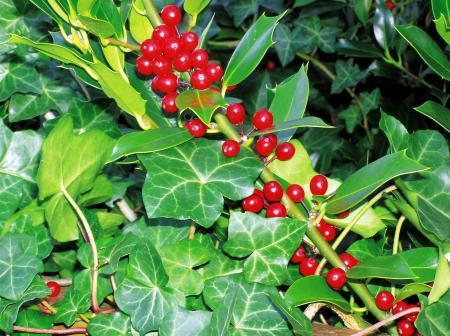 | |
| A traditional combination of two broadleaf evergreens; the rich holly berries add a punch of colour to lush ivy foliage. |
Who doesn't want to see a shot of colour in the garden on a dull winter day? Berry bushes may have fallen out of favour, but their undeniable qualities -- seasonal interest, attracting wildlife, beautiful colour -- have gardeners lining up to get their hands on these forgotten treasures of the four-season garden.
Bob Osborne of Nova Scotia's Cornhill Nursery says the popularity of landscaping plants seems to run in cycles. Plants that provide showy berries in winter have been forgotten, he says. "But, I think we are just discovering them again, in a sense," he says. The good landscape architects have always utilized winter's bright berries or bright-foliaged bushes to create colour around buildings. But, the focus is returning to combine more of these plantings into everyday gardens.
Osborne says he recently tore out a number of honeysuckle bushes at his home and planted the area with a hedge of deciduous holly (Ilex decidua). "My wife asked me why I was planting these bushes," he says, as they didn't look impressive at the time. They are now four feet tall and hung with masses of red berries in winter. "They are gorgeous," he says. The bushes also provide nice cuttings for indoor holiday decor.
Marc Ouellet, owner of Rockwood Forest Nurseries in Ontario, agrees that plant trends are cyclical. Just as styles or colours of furniture go in and out of fashion, so do plants, which are often linked to a certain era or trend. "If you look at older homes, they have more traditional plants such as bridalwreath spirea," he says. Someone renovating an older home, or a home built in an older architectural style, might opt for these nostalgic plants to ensure that the garden reflects the home's architecture. In new homes, however, winter berried bushes seem to have been overlooked.
While gardening is a popular leisure activity across Canada, the curtain often comes down on the garden in late summer. Unfortunately, gardeners are missing out on a host of winter pleasures. Berry bushes attract wildlife to the garden, and provide a show-stopping array of colour -- orange, red, yellow, black and blue -- all of which look beautiful against a backdrop of snow. The winter garden can be a serene place to visit, or to enjoy from indoors.
|
Real appeal Brenda Belec of Ontario's Medallion Perennials (Willowbrook Nurseries) says year-round appeal in the garden is strong with buyers. "Shrubs with colourful fall foliage, which ties in with the increased trend of fall decorating with corn stalks, gourds or pumpkins, extends into winter with shrubs that provide textured bark, twisting branching and with seeds or berries. With snow on the ground, these features are even more outstanding," she maintains. The trend is also being seen at the retail level with customers asking for bushes with a showy berry that will spice up the garden. Possible reasons include aging baby boomers spending more time at home, as well as increased interest in attracting birds to the garden. Parksville, on B.C.'s Vancouver Island, is a popular retirement community, with attractive beaches and a moderate climate. In October, retail outlet Cannor Nursery saw one of its busiest sales days with many shoppers out looking for fall colour. Berried bushes were in high demand, says horticulturalist Kristi Ozero. It helped that several Sorbus 'Pink Pagoda' trees were in bloom near the garden centre. Their stunning show sent a stream of customers, clutching berries in hand, shopping for the tree and emptying inventory, says Ozero. Callicarpa (beauty berry) is also selling like hot-cakes, says Ozero. It comes in a range of colours from purple to lavender with rich clusters of bead-like berries that are stunning in winter. The leaves turn bronze-purple in fall, leaving bare branches with clusters of purple berries that make attractive additions to wreaths and arrangements. Ozero says customers also favour the arbutus or strawberry tree, which becomes covered in strawberry-like red berries in winter. Belec recommends firethorn (Pyracantha), Viburnum tinus, dwarf burning bush (Euonymus alatus 'Compactus') and Chinese bearberry (Cotoneaster dammeri). Increased interest in native plants from coast to coast has also added to the popularity of berry-producing bushes. Ozero says that native salal with black berries, bunchberry with its red clusters of berries, lingonberry with red fruit, and the cherry-like berries of wintergreen, are all popular native plants. Joe Covell of Bunchberry Nursery in Nova Scotia finds that landscapers often opt for native holly, but says there are more exotic types available, such as variegated or blue holly, although a male ('Prince') and female ('Princess') plants are required to set berries. "I have been promoting some of the crabapples such as 'Tina'," says Covell, adding this dwarf shrub (it usually grows to six feet) has a wonderful show of white flower followed by "amazing" red fruit. "It is one of my favorites and it doesn't get the diseases other crabapples do," she says.
Get the show on the road After late fall, most of the industry is clearing out inventory and getting ready for Christmas, he says. At that time, berry bushes are usually in small containers, destined for the porch or to be used for cuttings. Intven agrees that bird watching is growing in popularity, and adds, "Maybe we are missing the boat." The problem, says Intven, is visibility. When the shrubs, trees, and plants show their berries best, it is not an ideal time for spading them into the garden. The plant's ability to show and the will to garden are on different paths. But Mother Nature might be changing all that. Rockwood's Ouellet says the drier summers across Canada are stressing plants and the natural reaction is to set more flowers -- causing flora to set more berries. "I think we are noticing berries because there are more of them," he says. At Edmonton's Nature Everblooming Garden Centre, sales staff have noticed a sudden increase in customers looking for berry bushes in the winter. Tree lot salesman Arno Wittenbecher says customers are usually looking for colour and there is an opportunity to introduce them to plants they may not know -- even when winter is a distant thought. Wittenbecher says highbush cranberries (both the European and American) are popular, edible, and hearty. "We carry lots of mountain ash," he says, such as American mountain ash, showy mountain ash (biggest berries), European mountain ash, Russian mountain ash, and others. "The cedar waxwings really like the berries," he says. Other berry-producing plants include arrow-woods (Viburnum) and sea buck-thorn, a hardy plant that can withstand minus 40-degree temperatures. "Another one that I really like is Russian olive -- you get a nice silver foliage and plentiful fruit," he says. Popular in colder climates, serviceberry 'Autumn Brilliance' (Amelanchier x grandiflora) has foliage that turns red and orange, and in autumn, sets dark purple fruit from white spring flowers. Chokeberry is known for its brilliant red fall colour and dark fruit that is popular with birds. Wilson's Greenhouse and Garden Centre in Saskatoon faces the challenge of marketing in an extreme climate. Supervisor Diane Jalbert says there is interest in fall and winter colour in the garden, but it is difficult to find plants that will survive extreme cold temperatures. However, trees such as mountain ash and some crabapples have worked well. Jalbert says the store keeps an eye out for new varieties available to gardeners in zone 2B. Two crabapples that are proving especially popular are 'Thunderchild' and 'Royalty'. Both provide a good show of foliage, flower, and decorative fruit. "Anything that's hardy is snapped up," she says. Nova Scotia's Osborne gives seminars on berry bushes and promotes their use in the winter garden. "It's one of the things we can do as a selling point for the high-bush cranberry and other viburnums," he says, adding the bushes are also attractive to gardeners who are interested in birds.
Creating berry special places When plants are placed for show, they should provide a good sight line for viewing, away from pedestrian areas where dropped fruit could be stepped on and tracked indoors. Taller berry bushes or trees can provide a background for lower-growing spring bulbs and summer flowers, while limiting access to the berries. In winter, when the ground in front is bare, the shrubs and trees provide the backdrop of colour. Placed outside a sunroom, berry bushes are an artful addition to the landscape, providing endless opportunities for bird watching. Jean Sorensen is a freelance writer based in Vancouver, B.C. Her work has appeared in business and trade publications. |
